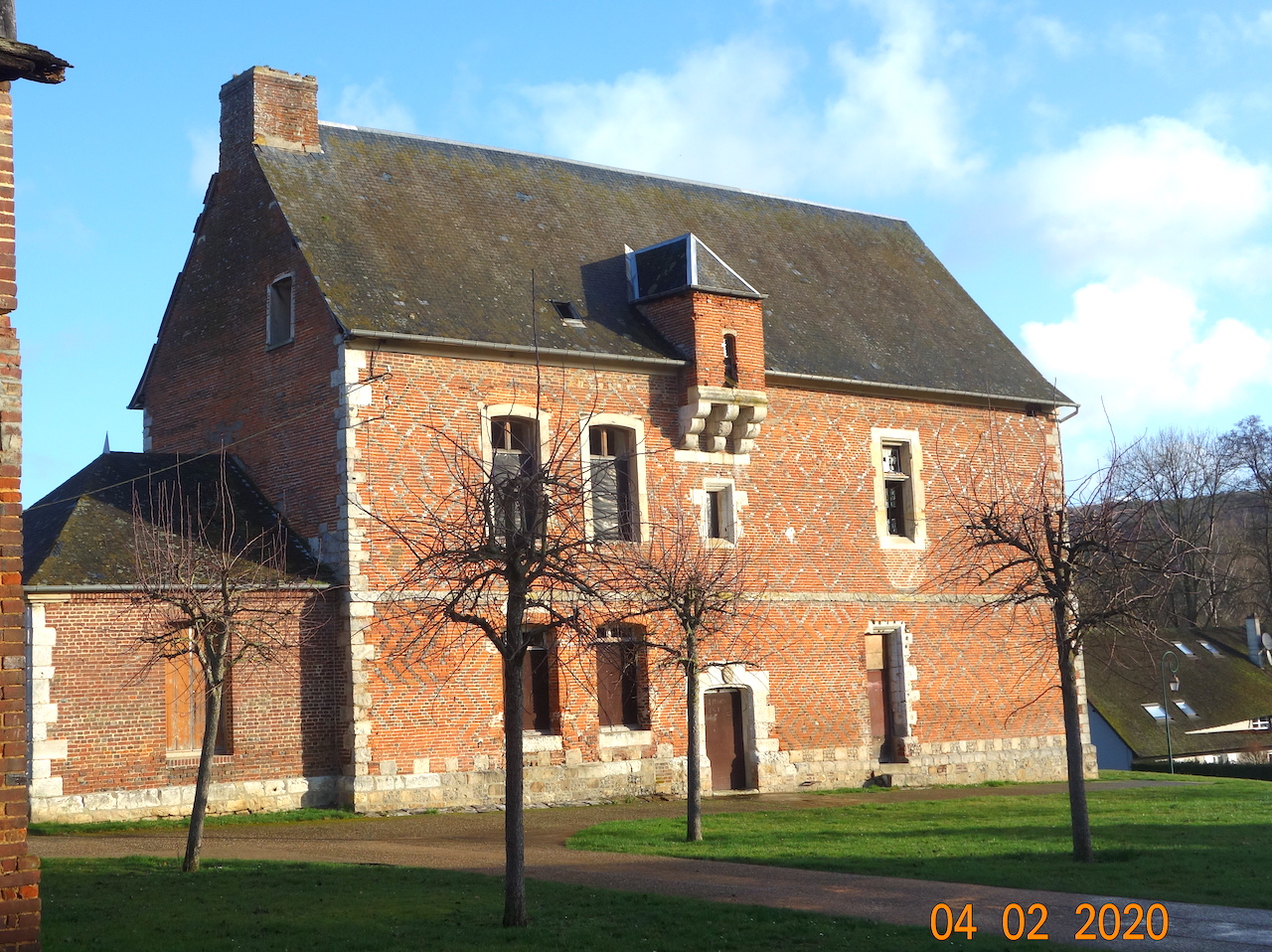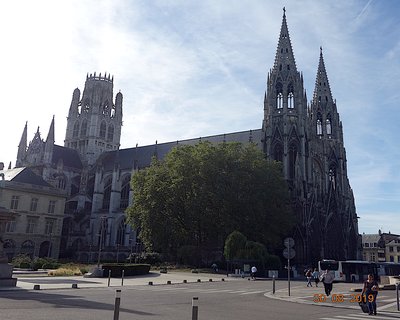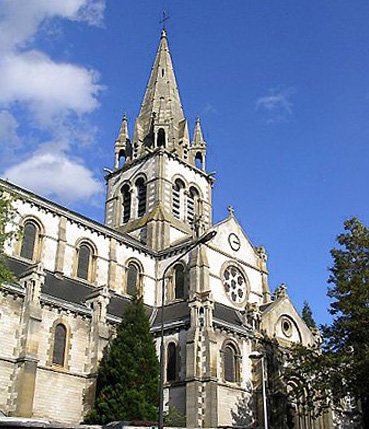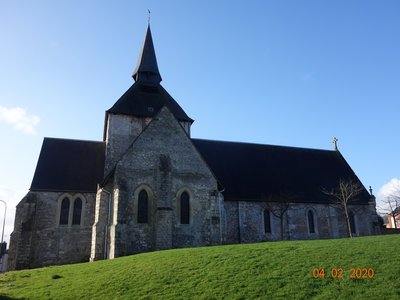Rouen to Perriers-sur-Andelle

Normandie
1. Rouen to Perriers-sur-Andelle
Medium
6h30
24,8km
+328m
-296m
Step
Embed this item to access it offline
The stage starts in the suburbs of Rouen and then crosses forests and cultivated fields, passing through villages in the Normandy plain.
3 points of interest

L’église abbatiale Saint-Ouen de Rouen - Amis saint Colomban St ColumbanAbbey Church of Saint-Ouen Abbey
Saint Ouen, Dadon his birth name, was bishop of Rouen from 639 to 689 and was blessed by Saint Colomban during his visit to Ussy-sur-Marne at the home of his father Authaire in 610. He became a faithful disciple of Luxovien monasticism practising the rule of the good Fathers Benoit and Colomban, a formula mentioned in the foundation charters that have come down to us. It was under his episcopate that Luxovien monasteries were established in the Seine valley. Bishop Ouen will be present on the foundation charters of the abbey of Fontenelle (Saint Wandrille), Jumièges (Saint Philibert), La Trinité à Fécamp, the abbey of Montivilliers, the abbey of Pavilly.
Saint-Ouen Abbey was founded after the death of Saint Ouen around 750. The church replaced a chapel housing the tomb of Saint-Ouen.
The abbey of Saint-Ouen was one of the most powerful Benedictine monasteries in Normandy. After the Revolution, the municipality moved into the former monks' dormitory, a beautiful classical building from the mid-18th century. The abbey church, which many visitors take for the cathedral because of its majestic proportions, stands in the former gardens of the convent. Saint-Ouen is thus one of the rare examples of the radiant Gothic. Its proportions are imposing: 137m long under 33m of vaults. The interior will amaze you with its slender architecture and its exceptional luminosity. A series of 80 original stained glass windows still decorate the three levels of the church. The great organ, the last of the great instruments made by Cavaillé-Coll, another title of glory of Saint Ouen, is one of the most recorded instruments in the world.
More information Wikipedia
Église Saint-Hilaire à Rouen - Jean Mamez site clochers-org TouristSaint-Hilaire Church in à Rouen
The church of St-Hilaire was located outside Rouen, in the Robec valley. The parish covered a suburb of rather poor weavers. The origins of the small medieval chapel are not known.
Destroyed several times, it was rebuilt several times and enlarged over the centuries.
It was closed in 1793 and was restored in 1802,
When it became a parish church, it was later found to be too small and unsightly. A new church replaced the old construction. Its foundation stone was laid on April 17, 1875.
It was built in a Gothic style described as "transitional". Its style borrows from Romanesque and Gothic. The building was consecrated on 14 January 1878.
The choir has two bays and a three-sided apse. It is framed by two wings terminated by apsidal chapels. One is dedicated to the Virgin Mary, the other to Saint Joseph.
The very wide transept is illuminated by two roses. To the north is the sacristy and to the south, a colonnade. The nave is 16 m wide and 17 m high. It has four bays. The last bay is surmounted by the organ loft.
The bell tower is at the crossing of the transept. It carries a stone pyramid dampened by four bells.
The church has a remarkable wrought iron choir grille with ornaments made by the Rouen ironmonger Ferdinand Marrou towards the end of the 19th century. The choir is decorated with a fresco depicting the Council of Seleucia of 359, where Saint-Hilaire was represented.
The fresco of the lantern is illustrated with the patron saints of the church of Rouen.
The stained glass windows are by Boulanger. They are illustrated with the main features of the story of Saint Hilaire.
L’église Saint-Étienne de Perriers-sur-AndelleL’église Saint-Étienne de Perriers-sur-Andelle - Association Colomban en Brie TouristSaint-Etienne Church in Perriers-sur-Andelle
The parish dedicated to Saint Etienne, together with the Perriers estate, was given to the Abbey of Saint-Ouen de Rouen in 1050 by William, Count d'Arques, and his brother Archbishop Mauger. The present building is a vast cruciform flint construction of Romanesque origin. At the end of the 11th century, the plan of the building, the transept, the bell tower on the crossing of the transept and the walls of the nave belong to the building. The buttresses of the nave were added in the 13th century. The western façade was rebuilt after 1868 by the architect Simon, in the style of the 13th century, as were the bays of the nave. In the 14th century, the crossing was vaulted with ribbed vaults and the choir had a flat chevet. Inside, the nave is roofed with a roofing framework with exposed crosspieces and punches, moulded sandpits and painted decoration from the end of the 16th century. In the choir is an 18th century painted and gilded altarpiece and a large 19th century glass roof by Duhamel Marette.
In Perriers-sur-Andelle, thistle was grown for the cloth factories of Louviers and Elbeuf. In 1840, three cotton mills, four wheat mills and a fuller's mill were built on the river as well as brick and plaster factories.
Description
In front of the Saint-Ouen abbey church, turn right into rue des Faux, rue Saint-Vivien, rue Saint-Hilaire, straight ahead at the roundabout on place Saint-Hilaire, route de Darnétal, go under N 28, straight ahead towards Darnétal.
- Turn right on D 138, rue Lucien Fromage, cross the Boulevard de la Paix, first street on the left, rue Charles Benner, turn right under the railway bridge, rue aux Juifs, Grande Rue.
- Second street on the left, rue du Lavoir, on the right rue du Cantony, at the end of the rue du Cantony on the right rue du Vieux Château, on the left at the crossroads with D 42 route de Lyons-la-Forêt
- Before the sports field on the right take the stairs and cross the parking lot, on the left Chemin du Vert Buisson, on the left at the junction with D 7, rue de l'Église, on the right in front of the Saint-Aubin church, take the pedestrian path that runs along the Sente de la Ravine brook
- Chemin de la Source on the left, on the right route de Lyons-la-Forêt, on the right chemin du Château, take the path of the Ravine on the left, walk on the pedestrian path parallel to the D 42, in Épinay first street on the right, route du Faulx, on the left path between houses with red and white markings
- Turn left at the crossroads Chemin du Bois des Chartreux, right Route de Lyons-la-Forêt, at the exit of Épinay first stone-paved path on the left after the field, red and white markings follow the Ravine stream, after the source of the Ravine path on the right red and white markings in the woods
- Left at the crossroads rue de la Grenouillette, second street on the right chemin du Puits, stay on your left grassy path between fields, left at the crossroads with rue de Coqueréaumont, you leave the red and white markings straight ahead at the crossroads with rue Croix de Trouville D 53, left direction Fresnay rue des Prairies, right at the crossroads D 13 rue de Martinville
- Left, rue des 3 Cornets, route du Nesnil Claque, left at the crossroads D 42, route de Lyons-la-Forêt, straight ahead D 18, rue des Canadiens D 42 in Perriers-sur-Andelle left at the crossroads rue du Général de Gaulle, second street on the right rue de l'Église you have arrived.
- Departure : Abbatiale Saint-Ouen, Place du Général de Gaulle. Rouen
- Arrival : Saint-Étienne Church, 11 rue de l’église 27 910 Perriers-sur-Andelle
- Towns crossed : Normandie
Altimetric profile
Report a problem or an error
If you have found an error on this page or if you have noticed any problems during your hike, please report them to us here:






